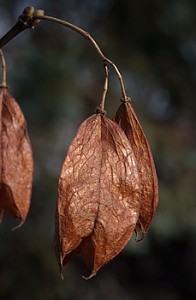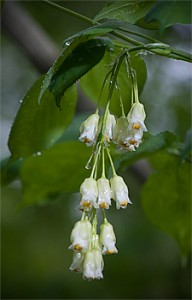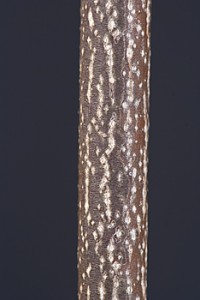One winter day, when I was about ten-years old, my father took me for a walk in Bloomer State Park. It was a cold, clear day with a slight breeze. We were walking quietly along a trail birding and heard a rattling sound. The sound came from brown, papery pods of a shrub that looked like an escaped ornamental. There were 100s of them hanging on striped branches. The rounded leaf buds were opposite and the twigs had false terminal buds. [Opposite buds are in pairs and false terminal buds can be at the ends of twigs but they have a leaf scar.] After returning home, I looked in The Shrub Identification Book by George Symonds and discovered that they were Bladdernut (Staphylea trifolia) pods.
The following May we visited the Bladdernut colony again to look for flowers. The flowers are greenish-white bells that hang in panicles. A panicle is a group of flowers on a branched stem. Flowers occur when the leaves begin developing. They are a pretty sight in the springwoods. The opposite leaves have three leaflets and fine teeth.
Staphyleaceae is a small family of approximately 50 species worldwide. Michigan’s only member is the Bladdernut. Its native range in Michigan is south of Bay City. The seedpods are buoyant raising the question of their dispersal via water.
This distinctive plant is great in the garden with its attractive flowers, interesting fruit, and striped twigs. It suckers freely and normally forms a dense clump. It grows in medium shade and does not do well at a dry location. Garwood and Horvitz report that this “is a self-incompatible temperate woodland shrub.” This means two plants are required for heavy seed production. However, they provide data that show some pods form with only a single plant. My single plant produces 10-30 pods a year. Bladdernut is best grown from seeds, but they are double dormant. This means that without treatment the seeds require two freeze cycles before they germinate. Seeds planted in the fall will emerge in the second year.
If you are walking along a river or in a floodplain look (or listen) for this plant. I love to find this plant. Maybe I’ll go to Bloomer Park and see if the colony still exists forty-three years later.
Don Drife
Works Cited
Garwood, Nancy C. and Carol C. Horvitz. Factors Limiting Fruit and Seed Production of a Temperate Shrub, Staphylea trifolia L. (Staphyleaceae). American Journal of Botany, Vol. 72, No. 3 (Mar., 1985), pp. 453-466. Article Stable URL: http://www.jstor.org/stable/2443538.
Symonds, George W. D. The Shrub Identification Book. M. Barrows and Co: New York, 1963. [This useful pictorial guide for identifying shrubs is still in print. The scientific names are a little dated but this is a minor detail.]




